Few garden plants give as much pleasure with as little effort as daffodils. They are one of the most vigorous and colorful flowers of spring. With good drainage they thrive in most soils, although they prefer a medium-heavy loam.
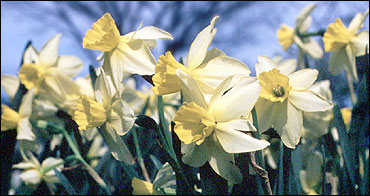 Planting of naturalized daffodils.
Planting of naturalized daffodils.
Daffodil, narcissus or jonquil?
Much confusion has existed over the proper name for these plants. Actually, both daffodil and narcissus are correct. Narcissus is the generic botanical name given to these plants in 1753. In England, however, the plants commonly were known as daffodils. This term was carried to other countries by English-speaking people. Jonquil refers to a specific kind of narcissus, and is not correct for the group in general. True jonquils have a reed-like leaves and fragrant flowers. Narcissus, then, is the correct botanical name for the genus; daffodil is the correct common name for all members of the genus; and jonquil correctly refers to one particular division of the genus.
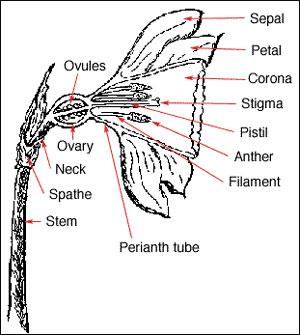 Figure 1
Figure 1
Parts of the daffodil flower.
Parts of the flower
The daffodil flower is distinctive in form and consists of a central whorl of tepals (the corona) surrounded by a ring of petals (Figure 1). Daffodils may be separated into 13 major divisions based on several distinctive forms of the flower (Figure 2).
Corona, trumpet or cup
The center part of the flower, which may range from a long, tubular part to a short, flattened disc. If the corona is longer than the petals, it is commonly referred to as a trumpet; if it is shorter, it is known as a cup.
Perianth
The circle of three petals and three sepals surrounding the central cup or trumpet.
Length of perianth segment
Refers to the petal length from its junction with the corona to its tip.
Length of the corona
Measured from its junction with the petal to the end of its furthest extension when flattened out.
Site selection
Drainage
Perhaps the most exacting need of daffodils is good drainage. Bulbs planted in poorly drained locations become weakened, fail to flower and often develop bulb rots. Bulbs in locations that remain moist during summer when soils are very warm develop rots easily. If drainage cannot be improved, raised beds should be built for the daffodils
Light
Daffodils must have sunlight to continue to develop and flower year after year. Since much of their growth is completed before trees fully leaf out, they may be grown beneath trees. In such locations, they may need additional water and fertilizer to compete with tree roots. Plant them where they get at least a half day of sunlight. Avoid north sides of buildings and tall, dense trees such as evergreens.
Soils
Because of their need for well-drained conditions, they grow poorly in tight soils that have poor internal drainage even though a location with good surface drainage has been chosen. The natural soil type should not deter anyone from growing daffodils, however, as soils may be improved.
Since the base of the bulbs should be set 5 to 6 inches below the soil surface, and since root feeding is below that level, soil should be worked deeply — about 10 to 12 inches. Light soils generally will not need many amendments, but in heavy clay soils add liberal quantities of coarse sand and some organic material such as peat moss or leaf mold. Animal manures tend to encourage the development of basal rot. In tight soil, as much as six bushels of organic material per 100 square feet of bed area may be added.
Fertilizing
Daffodils do not require heavy fertilization. When preparing the beds, use 2 to 3 pounds of a complete garden fertilizer such as a 6-24-24 or other fertilizer with a 1:4:4 or 1:3:3 N-P-K ratio. Incorporate this fertilizer into 100 square feet of soil along with the sand and organic material. Packaged bulb food is convenient to use. When planting bulbs in clumps rather than beds, about a handful of fertilizer per 12 bulbs will be adequate. Be sure to mix the fertilizer thoroughly with the soil. Never place it directly in the bottom of the hole. A high fertilizer concentration can kill newly emerging roots and promote bulb rots.
Where to plant
Daffodils are suitable for the shrub border, perennial beds and among groundcovers. They should be planted in groups of three to a dozen bulbs of one variety for the best effect. They are especially suitable for planting in front of evergreens that provide background and wind protection. Those planted near the house foundation in a southern exposure or those on a southern slope generally flower earlier than the same variety in another location.
Time to plant
Daffodils must have time to develop a good root system before cold weather sets in and the soil freezes. For this reason, planting before mid-October is generally best. In areas where cold weather arrives late, planting as late as Thanksgiving may still give good results. Select large, firm, healthy bulbs to get the most from your planting.
Planting
Spacing
Daffodils should be spaced 6 to 12 inches apart. For a quick display, the closer spacing should be used. Close spacing will require digging the bulbs about every three to five years. If you prefer to leave bulbs in one location longer, the wider spacing should be used.
Depth of planting
Daffodils should be planted so the base of the bulb is about 6 inches below the soil surface. In light soils, bulbs may be planted about 8 inches deep.
Mulching
Mulching daffodils helps keep soil temperatures uniform, retards weed growth and prevents mud spatter on the flowers during heavy spring rains. Pine needles, wood chips, shredded bark and aged sawdust are all good mulching materials. Peat moss tends to shed water and it splashes blooms badly during hard rains.
Watering
Daffodils must have good moisture to flower well. If rainfall is deficient, be sure to water bulbs well after planting and during the fall so that they can develop good roots. If the autumn or winter is dry or if the daffodils are planted under trees, be sure to give additional moisture.
Spring care
Daffodils need little care during the early spring. Established bulbs should be fertilized lightly each spring just as the leaves begin to come through the soil. Scatter a handful of a garden or bulb fertilizer lightly around each clump. Be careful not to get it on the new leaves or they may be burned. If any gets on the foliage, wash it off promptly. In naturalized areas, spread the fertilizer uniformly over the surface and water it in.
Watering
Both during and after flowering, daffodils need plenty of moisture to make active growth. During the summer, when the bulbs are dormant, they should remain fairly dry. Therefore, unless they are removed, daffodils should not be planted in beds that are heavily watered in summer.
After flowering
Daffodil leaves manufacture the food that is stored in the bulb and helps produce flowers the following year. Foliage should be allowed to remain on the plant undisturbed for eight weeks after bloom. After that period, it can be removed by hand-picking. The use of a knife or scissors to remove foliage encourages the spread of virus diseases and should be avoided. Tying the leaves together cuts down the amount of light they receive and reduces food production. When planted in borders, mix daffodils with daylilies, ferns or other plants that partially hide the foliage but still allow it to manufacture food for the bulb. Flower heads should be promptly removed to prevent seed production.
Dividing bulbs
If bulbs have not been planted too close together, daffodils need dividing only about every five to 10 years. Usually, when flowering is reduced or flower size becomes smaller, the time for digging and dividing has come.
Dig the bulbs while the foliage is dying and can still be seen so bulbs can be located. A spading fork is best to prevent bruising while digging.
Do not let bulbs lie in the hot sun after they have been dug. Remove loose soil and allow bulbs to dry in shallow trays, onion sacks or old nylon stockings.
Never pile up bulbs while drying or those on the inner part of the pile will be ruined. Allow bulbs to dry in a cool, well-ventilated place for several weeks. Discard any that rot.
After bulbs are dry, the offsets may be removed from the mother bulb, provided they can be separated easily (Figure 3). Remove old, dried skins and roots. After division, place them in a cool, dry location in shallow trays or porous sacks until planting time in the fall. Burlap sacks do not give enough ventilation. Some of the poeticus narcissi have a short dormant period and should be planted immediately after drying.
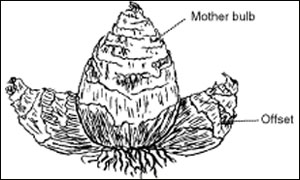 Figure 3
Figure 3
Offsets may be removed when the bulb is dry.
Insects and diseases
Daffodils have few insect and disease pests. Healthy bulbs planted in a good location will have few problems once established.
Bulb rots are perhaps the most frequent cause of disappointment. Plants that have been attacked may not emerge or may have weak or blighted leaves. Bulbs usually begin to rot at the base.
To control the problem, plant high-quality bulbs, well cured and free of cuts or bruises. Well-drained soil is essential to keep the problem from developing. Avoid over-fertilization, especially with nitrogen or manure. Diseased plants should be immediately destroyed so the problem does not spread.
Forcing daffodils for indoors
Daffodils are not difficult to force in the home. Begin the forcing process about Oct. 1. Large bulbs will provide the best results. Soaking the bulbs in a rooting hormone for 24 hours before planting helps develop good root growth. Use a 6- to 8-inch pot with drainage. Use a well-drained soil and fill the pot to 2 inches from the top. Add the bulbs close together and fill the pot with soil. About 5 bulbs may be planted in a 6-inch pot. The noses of the bulbs should be exposed. Water plants thoroughly. Fertilizer will not be needed.
Place the pots in a trench outdoors and cover with soil or soil and leaf mold or peat moss so the pots are covered about 6 inches. The pots may be taken indoors for forcing when they show good top growth and flower buds are clearly visible. This usually takes 10 to 12 weeks. When the pots are first taken indoors, they should be kept in a cool room where temperatures are about 50 to 55 degrees Fahrenheit for about two weeks. During the next two weeks, they should have temperatures about 60 degrees Fahrenheit. By this time flowers should begin to open and plants may be moved where desired. Keep the plants well watered. Not all varieties force well. In general, the earliest bloom-date for plants forced in this way is Valentine's Day. Some cultivars that force well are Abba, Avalanche, Beryl, Bridal Crown, Cantitrice, Carbineer, Carlton, Cragford, February Gold, Fortune, Geranium, King Alfred, Peeping Tom, Printal, Saint Keverne and Silver Chimes.
Selecting varieties for outdoors
Many daffodil cultivars are available in a wide range of types and prices. Most can be grown with some success in our area. Others show more vigor and durability. We cannot begin to name all suitable cultivars. Gardeners are urged to access the American Daffodil Society website, daffodilusa.org, for a complete list of cultivars. If a desired cultivar is not available locally, it generally can be obtained from bulb and daffodil specialists commonly listed in popular garden magazines.
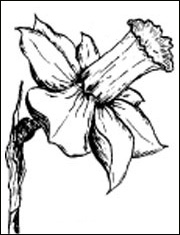 Division 1
Division 1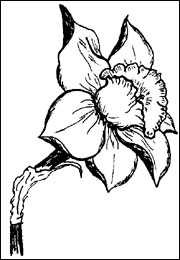 Division 2
Division 2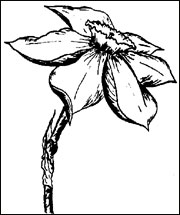 Division 3
Division 3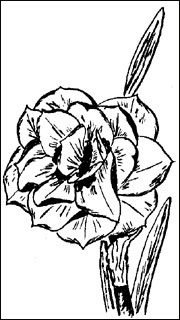 Division 4
Division 4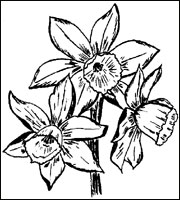 Division 5
Division 5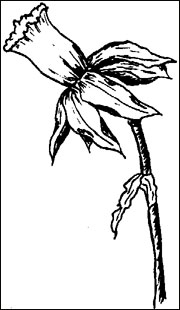 Division 6
Division 6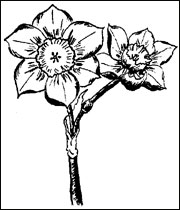 Division 7
Division 7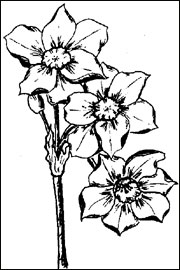 Division 8
Division 8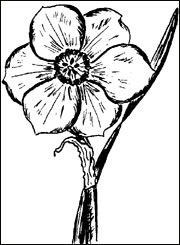 Division 9
Division 9 Division 10
Division 10 Division 11
Division 11